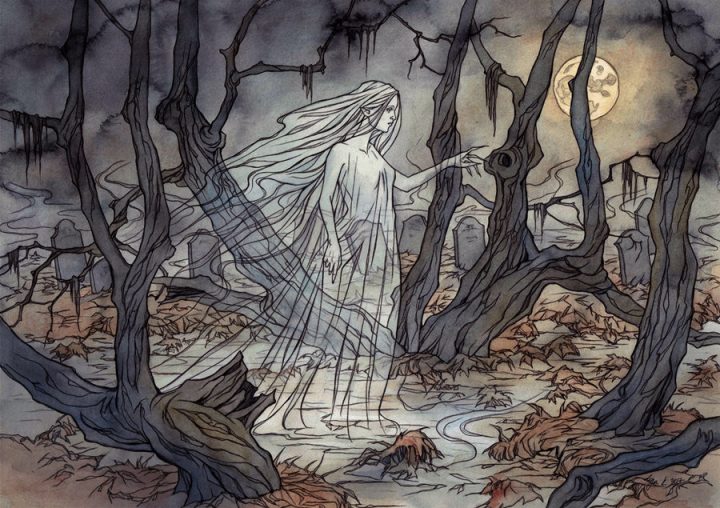Requiescat è la più gotica delle composizioni dell’album Girdenwodan part 1 dei Caprice, brano che mette in musica la poesia omonima di Oscar Wilde: il canto si apre operisticamente, come un requiem mozartiano, con il coro che proclama il titolo.
La collocazione del brano nell’album ci pone davanti alla grande domanda: cosa succede dopo la morte, qual’è il legame con il mondo dei viventi? Si veda anche il tema dell’amore oltre la morte
[English translation]
Requiescat is the most gothic of the compositions of the album Girdenwodan part 1 by Caprice, a piece that sets to music the homonymous poetry of Oscar Wilde: the song opens theatrally, like a Mozartian requiem, with the choir that proclaims the title.
This song on the album presents us with the big question: what happens after death, what is the link with the world of the living? See also the theme of love beyond death
Traduzione italiana Cattia Salto
(Riposa in pace, riposa in pace)
I (x2)
A passo lieve- lei è vicina sotto la neve,
parla piano-lei ascolta le margherite spuntare .
Chorus
Candido giglio, bianca neve, candido giglio, bianca neve,
Conosceva appena conosceva appena
il suo essere donna, così il suo essere donna, così
gentilmente cresceva gentilmente cresceva.
II (x2)
Lo splendore dorato dei suoi capelli che arrugginisce,
lei giovane e bella che diventa polvere.
[Chorus]
(Riposa in pace, riposa in pace)
III (x2)
Asse di bara, pietra di tomba le premono il seno
io mi tormento il cuore, solo, lei è morta.
IV bridge (x2)
Silenzio, silenzio, lei non ode
arpa o sonetto (arpa o sonetto )
tutta la mia vita è qui sepolta, ricopritela di terra
V
A passo lieve- lei è vicina sotto la neve,
parla piano- lei ascolta le margherite spuntare .
Asse di bara, pietra di tomba le premono il seno
io mi tormento il cuore, solo, lei è morta
io mi tormento il cuore, solo, lei è morta (lei è morta)
NOTE
(1) il poeta esorta a camminare piano e a parlare sommessamente per non disturbare il sonno della defunta
(2) la neve sulla terra richiama il candore e la purezza della fanciulla defunta
(3) secondo la critica la poesia fu composta per la sorella morta tanti anni prima (1869) ma il verso qui descrive una donna nella sua fanciullezza e poco si addice all’età bambina della sorella (nove anni)
(4) l’antenata dell’arpa ossia la lyra, uno strumento diffuso presso la cultura greca ai tempi di Omero, La lyra è indubbiamente uno degli strumenti a corda più antichi d’Europa e la ritroviamo ancora tutt’oggi in numerose tradizioni musicali nord-europee. continua

(Requiescat, requiescat)
I (x2)
Tread lightly, she is near under the snow,
Speak gently, she can hear the daisies grow. (1)
Chorus
Lilly-like, white as snow, Lilly-like, white as snow (2),
She hardly knew she hardly knew
She was a woman (3), so she was a woman, so
Sweetly she grew. Sweetly she grew.
II (x2)
All her bright golden hair tarnished with rust,
She that was young and fair fallen to dust.
[Chorus]
(Requiescat, requiescat)
III (x2)
Coffin-board, heavy stone, lie on her breast,
I vex my heart alone, she is at rest.
IV bridge (x2)
Peace, Peace, she cannot hear
Lyre (4) or sonnet (lyre or sonnet)
All my life’s buried here, heap earth upon it.
V
Tread lightly, she is near under the snow,
Speak gently, she can hear the daisies grow.
Coffin-board, heavy stone, lie on her breast,
I vex my heart alone, she is at rest.
I vex my heart alone, she is at rest (she’s at rest).
FOOTNOTES
(1) the poet exhorts to walk slowly and to speak softly in order not to disturb the sleep of the deceased
(2) snow on earth recalls the candor and purity of the deceased girl
(3) according to the criticism, the poem was composed for the sister who died many years before (1869) but the verse here describes a maid and is little suited to the child’s age of the sister (nine years)
(4) the ancestor of the harp or the lyra, a widespread instrument in Greek culture at the time of Homer, Lyra is undoubtedly one of the oldest stringed instruments in Europe and we find it still today in many northern musical traditions -europee. (see more)
